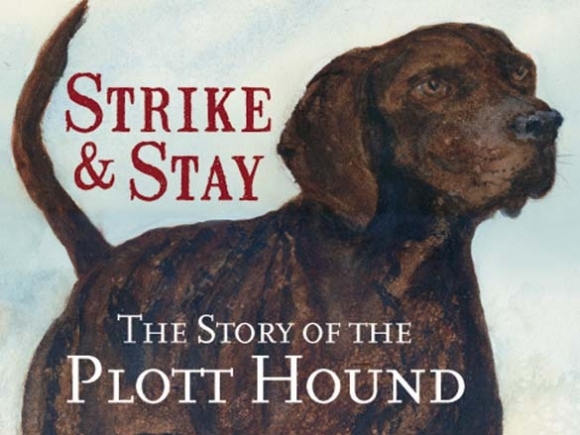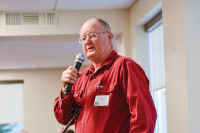Plott hounds hold unique place in WNC history

I had my first encounter with a prize-winning Plott hound several years ago when I was hosting a Liars Bench program at Western Carolina University. I had asked David Brewin to bring Nannie, his Plott hound, to the program.
As I remember it now, Nannie was not on a leash, but it seemed unnecessary. She came and sat by David and surveyed the people in the audience, her dark brendle coat shimmering under the lights. No stranger to crowds, she was calm, even composed and she seemed to briefly study each individual on the crowded stage.
When she looked at me, I was immediately aware that I was being studied (assessed) by an intelligent creature. No tail thumping or fawning, just a cool stare. I was seated nearby on the “liar’s bench,” and the program’s mascot, a life-sized, stuffed German Shepherd named Bodine, was sitting by me.
As Nannie surveyed the performers around her, her gaze halted on the big, fake German shepherd. She got up and walked over to Bodine. Silence fell on the stage as Nannie stood regarding Bodine’s stupid, smiling face. Then, she bent and sniffed his butt. Nannie gave a little snort and returned to her place by David where she gave Bodine a look of withering contempt. Then, she gave me a look that plainly said, “THAT is not even a dog.”
What is different about a Plott dog? Strike and Stay is Bob Plott’s definitive book that reveals, not only why the breed bears his name, but how two 18th century brothers (the sons of a Rhine Valley gamekeeper), brought five valuable hunting dogs with them and traveled to “the new world.” It is an astonishing story.
Traditionally, migrants came bearing the tools of their trade, the hammers, knives and weavers’ looms. The Plott brothers brought five hunting dogs which probably had “Hanoverian bloodlines,” but in the opinion of the author, they probably contained a “mix” of a number of breeds. They were examples of seasoned hunting dogs who would insure their masters’ survival because of their skills in tracking and bringing down deer, bear. If need be, they could herd sheep and pigs.
Related Items
Those five dogs not only survived; they flourished. In time they would play a vital part in Appalachian history and so would their owners.
The author’s research has uncovered a wealth of folklore and history concerning the dogs exploits, such as the story of left-handed Amos Plott, the grandson of one of the original brothers, George Plott) and his dog Porter, that died fighting a bear. Amos avenged Porter’s death by wrapping his right arm in protective covering and attacking the bear with only his left-handed hunting knife.
Strike and Stay contains numerous stories told by a host of noted hunters and woodsmen, such as Mark Cathey and Quill Rose, who notes that a Plott hound will “carry a grudge.” If a young Plott hound loses a fight, he will bide his time until an opportunity comes to avenge his defeat. There is evidence that a Plott that herds sheep or pigs will take note of a missing animals and go in search of them. All owners attest to the fact that Plott hounds “bond” with their masters and will protect them from attack, even if they die as a result.
The early history of Western North Carolina cannot be told without noting the persistent presence of Plott hounds. The achievements of noted explorers such as Guyot and the famous controversy attending Mitchell and Clingman’s conflicting claims about the highest peaks ... regardless of the purpose of these expeditions, the Plott hounds were there. In time, the most noted of these explorers acknowledged the fact that they owned much of their success to Plott hounds with their reputations for stamina, courage and dependability.
However, in addition to chronicling these feats, the author provides extensive information about the Plott family members who not only preserved the bloodlines of the Plott, but probably improved or “enhanced” them.
There is considerable controversy here. Some Plott breeders “improved” their bloodlines by including the traits of other noted hunting dogs, (such as the “leopard” Plott, which has different markings and traits.) According to the author, there is even evidence of the inclusion of wolf blood lines, which for a time was evident by producing Plott hounds with yellow eyes!
Such experimentation was carried out by members of the Plott family and other breeders. At times, the results caused dissension among some owners (including the Plott family) who took pride in what they considered “untainted” bloodlines. Some breeders even speak contemptuously of Plott “hounds” characteristics and consider “cur” qualities to be more desirable.
Despite this controversy, the reputation of the Plott line continued to flourish, and in 1935 a legendary bear hunt in Hazel Creek brought the Plott bear dog national attention. Organized by a professional baseball Hall of Fame member named Branch Rickey, the hunt included two Plott family notables, Von and Little George Plott. This event became a record-setting hunt that contained over 18 “notable” Plott dogs and netted eight bears killed (jumped 20) and lasted three days.
In conclusion, the author of Strike and Stay not only provides a comprehensive history of the Plott hound in Appalachia, the author also provides a detailed history of what he considers to be Appalachia’s most venerable Plott breeders and their friends. Throughout this book, Bob Plott pays tribute to what he calls “The Big Five.” They are as follows:
• John and Vaughn Plott: These two brothers are classic examples of opposing views about Plott blood lines and infusions of “outside” stock such as the leopard Plott which was bitterly opposed by Vaughn and accepted by John. Despite their opposing views, both men were dedicated to the preservation of the Plott hound.
• Gola Ferguson: The author dubs Gola as a “renaissance man,” a distinction that he richly deserves. Teacher, Swain county sheriff, gifted storyteller and public speaker, Gola was also an accomplished luthier, or violin make. Ferguson also ran for Congress in 1942. Gola’s dedication to hunting lead him to maintaining 20 to 30 Plott hounds and is credited with developing his own unique breed of Plotts.
• Howe-Taylor Crockett: Howe-Taylor spent much of his life in Waynesville but became noted for his athletic abilities at Brevard College. He became an ardent hunter of Plott hounds and participated in some 50 hunts for wild boars. A highly decorated soldier, Howe-Taylor was awarded two Purple Hearts during WWII for his service in Africa, Sicily and Italy. After the war, he became a dedicated breeder of a remarkable Plott hound bloodline.
• Isaiah Kidd: Born in Beckley, West Virginia, Isaiah acquired some North Carolina Plott hounds at an early age and became a respected breeder and hunter who often ventured into the rugged North Carolina mountains on hunting trips. His detailed records, which he maintained for 40 years, have proven him to be one of the region’s most accomplished Plott breeders.
In addition, Strike and Stay is generously illustrated with photographs of the famous Plotts, both dog and family. The book contains information gleaned from Foxfire and noted publications dealing with hunting and breeding. Of especial interest are accounts of the origin of a wildlife preserve in Graham County and the use of Plott hounds in the hunting of wild boar ... a significant event that deserves its own book.









